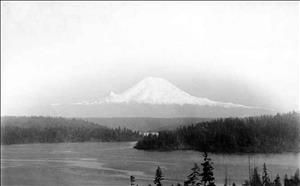Seward Park abarca la totalidad de una península que se interna en el Lago Washington desde el sudeste de Seattle, además de su istmo y algunos acres de tierra firme a lo largo de la costa. El sitio de 300 acres incluye 120 acres de bosques nativos sin explotar - el mayor grupo de árboles antiguos en la ciudad. El potencial de la península como un parque fue reconocido a principios de la década de 1890. Fue un elemento clave en el plan propuesto por los famosos Olmsted Brothers para el sistema de parques de Seattle en 1903. Después de que la ciudad adquiriera la tierra en 1911, la firma Olmsted diseñó Seward Park como el punto central de un sistema panorámico de boulevard que se extiende varias millas hacia el norte a lo largo del lago. En la actualidad el parque es un refugio urbano que aloja una amplia variedad de flora y fauna, desde águilas calvas hasta el roble Garry, el único roble nativo de Washington. Sus amenidades incluyen millas de senderos para caminantes, un sendero costero de 2.4 millas para caminantes y ciclistas, una playa para bañistas, anfiteatro, estudio de arte y un centro medioambiental manejado en asociación entre la Sociedad Nacional Audubon (National Audubon Society) y el Departamento de Parques y Recreación de Seattle (Seattle Parks and Recreation Department) – además de magníficas vistas del Monte Rainier.
Seward Park (Seattle)
- By Cassandra Tate
- Posted 9/03/2010
- HistoryLink.org Essay 3141
Sources:
Donald Sherwood, "Seward Park -- History," December 3, 1973, in Sherwood Park History Files, Seattle Parks and Recreation website accessed August 2010 (http://www.seattle.gov/PARKS/history/sherwood.htm); Arthur Lee Jacobson, "Tall Tales from the Northwest: Best Trees of Seattle," Arthur Lee Jacobson website accessed August 2010 (www.arthurleej.com); Paul Talbert, "The History of Seward Park," Seattle Friends of Seward Park website accessed August 2010 (www.sewardpark.org); "Seward Park Comprehensive Trail Plan," May 1, 2009, Seattle Parks and Recreation website accessed August 2010 (http://www.cityofseattle.net/parks/environment/seward_park_trail_plan.pdf); Buzz Anderson, "Seward Peninsula Has Rich History," Beacon Hill News and South District Journal, August 1, 2001, p. 1; Kathy Mulady, "City Celebrates Park Pioneer Olmsted," Seattle Post-Intelligencer, April 2, 2003 (www.seattlepi.com); "Seward Park -- The Pride of Rainier Valley," Rainier Valley Citizen, December 29, 1915, p. 23; Sherry Stripling, "Seeds of Renewal," The Seattle Times, March 31, 2005 (www.seattletimes.nwsource.com).
Note: This essay replaces an earlier essay on the same subject.
Licensing: This essay is licensed under a Creative Commons license that encourages reproduction with attribution. Credit should be given to both HistoryLink.org and to the author, and sources must be included with any reproduction. Click the icon for more info. Please note that this Creative Commons license applies to text only, and not to images. For more information regarding individual photos or images, please contact the source noted in the image credit.

